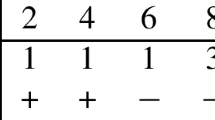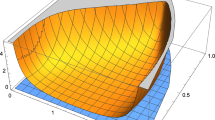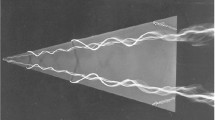Abstract
Consider the focussing cubic nonlinear Schrödinger equation in \({\mathbb{R}}^3\) :
It admits special solutions of the form e itα ϕ, where \(\phi \in {\mathcal{S}}({\mathbb{R}}^3)\) is a positive (ϕ > 0) solution of
The space of all such solutions, together with those obtained from them by rescaling and applying phase and Galilean coordinate changes, called standing waves, is the 8-dimensional manifold that consists of functions of the form \(e^{i(v \cdot + \Gamma)} \phi(\cdot - y, \alpha)\) . We prove that any solution starting sufficiently close to a standing wave in the \(\Sigma = W^{1, 2}({\mathbb{R}}^3) \cap |x|^{-1}L^2({\mathbb{R}}^3)\) norm and situated on a certain codimension-one local Lipschitz manifold exists globally in time and converges to a point on the manifold of standing waves. Furthermore, we show that \({\mathcal{N}}\) is invariant under the Hamiltonian flow, locally in time, and is a centre-stable manifold in the sense of Bates, Jones [BatJon]. The proof is based on the modulation method introduced by Soffer and Weinstein for the L 2-subcritical case and adapted by Schlag to the L 2-supercritical case. An important part of the proof is the Keel-Tao endpoint Strichartz estimate in \({\mathbb{R}}^3\) for the nonselfadjoint Schrödinger operator obtained by linearizing (0.1) around a standing wave solution. All results in this paper depend on the standard spectral assumption that the Hamiltonian
has no embedded eigenvalues in the interior of its essential spectrum \((-\infty, -\alpha) \cup (\alpha, \infty)\) .
Similar content being viewed by others
References
Agmon S. (1975). Spectral properties of Schrdinger operators and scattering theory. Ann. Scuola Norm. Sup. Pisa Cl. Sci. (4) 2(2): 151–218
Bates P.W. and Jones C.K.R.T. (1989). Invariant manifolds for semilinear partial differential equations. Dynamics Reported 2: 1–38
Berestycki H. and Cazenave T. (1981). Instabilité des états stationnaires dans les équations de Schrödinger et de Klein-Gordon non linéaires. C. R. Acad. Sci. Paris Sér. I Math. 293(9): 489–492
Berestycki H. and Lions P.L. (1983). Nonlinear scalar field equations. I. Existence of a ground state. Arch. Rat. Mech. Anal. 82(4): 313–345
Bergh, J., Löfström, J.: Interpolation Spaces. An Introduction. Berlin-Heidelberg-New York: Springer-Verlag, 1976
Buslaev, V.S., Perelman, G.S.: Scattering for the nonlinear Schrödinger equation: states that are close to a soliton (Russian). Algebra i Analiz 4(6), 63–102 (1992); translation in St. Petersburg Math. J. 4(6), 1111–1142 (1993)
Buslaev, V.S., Perelman, G.S.: On the stability of solitary waves for nonlinear Schrödinger equations. In: Nonlinear evolution equations, Amer. Math. Soc. Transl. Ser. 2, 164, Providence, RI: Amer. Math. Soc. 1995, pp. 75–98
Buslaev, V.S., Perelman, G.S.: Nonlinear scattering: states that are close to a soliton (Russian). Zap. Nauchn. Sem. S.-Peterburg. Otdel. Mat. Inst. Steklov, (POMI) 200 (1992), Kraev. Zadachi Mat. Fiz. Smezh. Voprosy Teor. Funktsii, 24, 38–50, 70, 187; translation in J. Math. Sci. 77(3), 3161–3169 (1995)
Cazenave, T.: Semilinear Schrödinger equations, Courant Lecture Notes in Mathematics, 10, New York University, Courant Institute of Mathematical Sciences, Providence, RI: Amer. Math. Soc., 2003
Cazenave T. and Lions P.L. (1982). Orbital stability of standing waves for some nonlinear Schrödinger equations. Commun. Math. Phys. 85: 549–561
Coffman C.V. (1972). Uniqueness of positive solutions of Δu−u + u 3 = 0 and a variational characterization of other solutions. Arch. Rat. Mech. Anal. 46: 81–95
Cuccagna S. (2001). Stabilization of solutions to nonlinear Schrödinger equations. Comm. Pure Appl. Math. 54(9): 1110–1145
Cuccagna S., Pelinovsky D. and Vougalter V. (2005). Spectra of positive and negative energies in the linearized NLS problem. Comm. Pure Appl. Math. 58(1): 1–29
Demanet L. and Schlag W. (2006). Numerical verification of a gap condition for a linearized NLS equation. Nonlinearity 19: 829–852
Erdogan, B., Schlag, W.: Dispersive estimates for Schrödinger operators in the presence of a resonance and/or an eigenvalue at zero energy in dimension three: II. To appear in Journal d’Analyse Mathematique, available at http://arxiv.org/list/math/0504585, 2005
Gesztesy F., Jones C.K.R.T., Latushkin Y. and Stanislavova M. (2000). A spectral mapping theorem and invariant manifolds for nonlinear Schrödinger equations. Indiana Univ. Math. J. 49(1): 221–243
Glassey R.T. (1977). On the blowing-up of solutions to the Cauchy problem for the nonlinear Schrödinger equation. J. Math. Phys. 18: 1794–1797
Grillakis M., Shatah J. and Strauss W. (1987). Stability theory of solitary waves in the presence of symmetry. I. J. Funct. Anal. 74(1): 160–197
Grillakis M., Shatah J. and Strauss W. (1990). Stability theory of solitary waves in the presence of symmetry. II. J. Funct. Anal. 94(1): 308–348
Hundertmark D. and Lee Y.-R. (2007). Exponential decay of eigenfunctions and generalized eigenfunctions of a non self-adjoint matrix Schrödinger operator related to NLS. Bull. London Math. Soc. 39(5): 709–720
Keel M. and Tao T. (1998). Endpoint Strichartz estimates. Amer. Math. J. 120: 955–980
Kenig C. and Merle F. (2006). Global well-posedness, scattering and blow-up for the energy-critical, focusing, non-linear Schrödinger equation in the radial case. Inv. Math. 166(3): 645–675
Kelley P.L. (1965). Self-focusing of optical beams. Phys. Rev. Lett. 15: 1005–1008
Krieger J. and Schlag W. (2006). Stable manifolds for all monic supercritical NLS in one dimension. J. AMS 19(4): 815–920
Krieger, J., Schlag, W.: Non-generic blow-up solutions for the critical focusing NLS in 1-d. http://arxiv.org/list/math/0508576, 2005
Krieger J. and Schlag W. (2007). On the focusing critical semi-linear wave equation. Amer. J. Math. 129(3): 843–913
Kwong M.K. (1989). Uniqueness of positive solutions of Δu−u + u p = 0 in \({\mathbb{R}}^n\) Arch. Rat. Mech. Anal. 65: 243–266
McLeod K. and Serrin J. (1987). Nonlinear Schrödinger equation. Uniqueness of positive solutions of Δu + f (u) = 0 in \({\mathbb{R}}^n\) Arch. Rat. Mech. Anal. 99: 115–145
Merle F. (1993). Determination of blow-up solutions with minimal mass for nonlinear Schrödinger equations with critical power. Duke Math. J. 69(2): 427–454
Merle F. and Raphael P. (2006). On a sharp lower bound on the blow-up rate for the L 2 critical nonlinear Schrödinger equation. J. Amer. Math. Soc. 19(1): 37–90
Perelman G. (2001). On the formation of singularities in solutions of the critical nonlinear Schrödinger equation. Ann. Henri Poincaré 2(4): 605–673
Pillet C.A. and Wayne C.E. (1997). Invariant manifolds for a class of dispersive, Hamiltonian, partial differential equations. J. Diff. Eq. 141(2): 310–326
Rodnianski I. and Schlag W. (2004). Time decay for solutions of Schrödinger equations with rough and time-dependent potentials. Invent. Math. 155(3): 451–513
Rodnianski I., Schlag W. and Soffer A. (2004). Dispersive analysis of charge transfer models. Comm. Pure and Appl. Math. 58(2): 149–216
Rodnianski, I., Schlag, W., Soffer, A.: Asymptotic stability of N-soliton states of NLS. http://arxiv.org/list/math/0309114, 2003
Schlag, W.: Stable Manifolds for an orbitally unstable NLS. http://arxiv.org/list/math/0405435 , 2004
Schlag W. (2006). Spectral theory and nonlinear partial differential equations: a survey. Discrete Contin. Dyn. Syst. 15(3): 703–723
Soffer A. and Weinstein M.I. (1990). Multichannel nonlinear scattering for nonintegrable equations. Comm. Math. Phys. 133: 119–146
Soffer A. and Weinstein M.I. (1992). Multichannel nonlinear scattering, II. The case of anisotropic potentials and data. J. Diff. Eq. 98: 376–390
Stein E. (1994). Harmonic Analysis. Princeton University Press, Princeton, NJ
Sulem, C., Sulem, P.-L.: The Nonlinear Schrödinger Equation. Self-focusing and Wave Collapse. Applied Mathematical Sciences, 139, New York: Springer-Verlag, 1999
Taylor, M.E.: Tools for PDE. Pseudodifferential operators, paradifferential operators, and layer potentials. Mathematical Surveys and Monographs, 81, Providence, RI: Amer. Math. Soc., 2000
Weinstein M.I. (1986). Lyapunov stability of ground states of nonlinear dispersive equations. Comm. Pure Appl. Math. 39(1): 51–67
Weinstein M.I. (1985). Modulational stability of ground states of nonlinear Schrödinger equations. SIAM J. Math. Anal. 16(3): 472–491
Yajima K. (2005). Dispersive estimate for Schrödinger equations with threshold resonance and eigenvalue. Commun. Math. Phys. 259(2): 475–509
Author information
Authors and Affiliations
Corresponding author
Additional information
Communicated by P. Constantin
This work is part of the author’s Ph. D. thesis at the University of Chicago.
Rights and permissions
About this article
Cite this article
Beceanu, M. A Centre-Stable Manifold for the Focussing Cubic NLS in \({\mathbb{R}}^{1+3}\) . Commun. Math. Phys. 280, 145–205 (2008). https://doi.org/10.1007/s00220-008-0427-3
Received:
Accepted:
Published:
Issue Date:
DOI: https://doi.org/10.1007/s00220-008-0427-3




